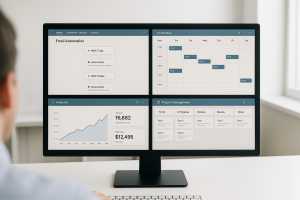“You need to work 80-hour weeks to build a successful online business.”
This is the biggest lie in entrepreneurship.
The truth? Most online business owners waste countless hours on activities that feel productive but don’t actually grow their business. They’re busy, exhausted, and overwhelmed – but not profitable.
 What if I told you it’s possible to build and run a profitable online business in just 3 focused hours per day?
What if I told you it’s possible to build and run a profitable online business in just 3 focused hours per day?
Not by working harder, but by working smarter. Not by cutting corners, but by focusing only on what truly matters.
Here’s the reality: there are only three core activities that actually grow any online business – driving traffic, converting that traffic into customers, and building systems that scale without you. Everything else is either support work (that should be outsourced) or busy work (that should be eliminated).
Today, I’m going to give you the complete blueprint for building a freedom-based online business that runs efficiently in 3 hours per day. You’ll discover exactly which tasks deserve your focused attention, what should be automated, and how to build a business designed for freedom instead of burnout.
Why a 3-Hour Workday Actually Works
Before you think this is some productivity hack or time management trick, let me be clear: this only works if you build your business with efficiency in mind from the start.
Time pressure forces brutal clarity.
When you only have 3 hours, you can’t waste time on “busy work” that feels productive but doesn’t generate results. You’re forced to focus on the core activities that actually grow your business: driving traffic, improving offers, and optimizing conversions.
You make fewer but better decisions.
With unlimited time, it’s easy to overthink every small detail. With a tight schedule, you learn to make quick, decisive choices and move forward. Most decisions are reversible anyway.
You focus on high-leverage activities only.
There are really only three things that matter in any online business:
- Getting qualified traffic to your offers
- Converting that traffic into customers
- Systematizing and scaling what works
Everything else is either support work (that can be outsourced) or distraction (that should be eliminated).
The key insight? This approach only works if you design your business around these constraints from day one. You can’t build a complex, time-intensive business and then try to compress it into 3 hours.
Your 3-Hour Business Structure (Template You Can Copy)
Here’s the framework you can adapt for your own business. This isn’t about copying my exact routine – it’s about understanding the principles and applying them to your specific situation.
Hour 1: Growth + Traffic
Your first hour should be dedicated to bringing new people into your world. This is the lifeblood of any online business, and it deserves your freshest mental energy.
Content Creation (40 minutes)
Pick ONE primary content format that aligns with your strengths and your audience’s preferences:
- Write blog posts if your audience prefers in-depth, searchable content
- Record videos if you’re comfortable on camera and your niche benefits from visual demonstration
- Create email newsletters if you have an engaged list and prefer direct communication
- Design infographics or carousel posts if your audience is visual and social media-focused
The key is consistency over perfection. I’d rather see you publish one solid piece of content every week for a year than create sporadic “masterpieces” that exhaust you.
Channel Management (20 minutes)
Choose 1-2 platforms where your ideal customers actually spend time, then focus your energy there:
- Check which content performed best in the last 24-48 hours
- Engage authentically with comments and messages (this builds real relationships)
- Share or repurpose your best-performing content to maximize its reach
- Make quick optimizations based on what’s working (better headlines, different posting times, etc.)
Don’t try to be everywhere at once. Master one or two channels before expanding. I’ve seen too many entrepreneurs spread themselves thin across six platforms and get mediocre results everywhere.
 Hour 2: Offers + Conversions
Hour 2: Offers + Conversions
This is where you turn your traffic into paying customers. Without this hour, you have a hobby, not a business.
Sales Process Optimization (30 minutes)
Look at your conversion funnel with fresh eyes every single day:
- Review yesterday’s sales metrics – which traffic sources converted best?
- Test small improvements to your sales pages (headlines, testimonials, CTAs)
- Update pricing strategies or payment options based on customer feedback
- Analyze email open rates and click-through rates to identify weak points
Small improvements compound dramatically over time. A 1% daily improvement in conversion rate doubles your revenue in just 70 days.
Offer Development (30 minutes)
Your offers should evolve based on what you learn from your customers:
- Create or improve entry-level products that introduce people to your brand
- Add limited-time bonuses or urgency to current campaigns (but only if it’s genuine)
- Plan launches for new products based on customer requests and market gaps
- Refresh your sales copy with new testimonials, case studies, or social proof
Remember, you don’t need to create something completely new every day. Sometimes the biggest impact comes from improving what you already have.
Hour 3: Systems + Team
This final hour is about building a business that can grow without consuming your entire life.
Delegation and Team Building (30 minutes)
Even if you’re a solopreneur starting out, think about what you’ll eventually want to remove from your plate:
- Document your processes as you do them (future you will thank present you)
- Identify repetitive tasks that could be assigned to a virtual assistant
- Create checklists and standard operating procedures for routine work
- Train team members using recorded videos or written guides
Start small. Maybe you outsource social media graphics first, then customer service, then content editing. Build your team gradually as revenue grows.
Systems and Automation Planning (30 minutes)
Look for patterns in your daily work that could be systematized:
- Set up email automation sequences that nurture leads while you sleep
- Use tools that automatically distribute your content across multiple platforms
- Create systems that tag and segment your audience based on their behavior
- Plan new automations that can eliminate repetitive manual tasks
The goal isn’t to automate everything immediately. It’s to consistently move toward a business that serves your customers even when you’re not actively working.
By the end of these three hours, you should have moved the needle on traffic, conversions, and systems. Everything else either gets automated, delegated, or eliminated.
What You Should Automate (So You Don’t Touch It Daily)
Automation is what separates successful online business owners from those who stay trapped in the daily grind. The goal is to set up systems that work 24/7, even while you sleep.
Here’s what should run without your daily involvement:
Email Marketing Systems
Your email marketing should be like a well-oiled machine that nurtures leads and converts customers automatically:
- Welcome sequences that introduce new subscribers to your brand and best content
- Product delivery systems that automatically send digital downloads and access information
- Abandoned cart recovery emails that re-engage potential customers who didn’t complete their purchase
- Behavioral triggers that send relevant offers based on what people click and buy
The beauty of email automation is that it scales infinitely. Whether you have 100 subscribers or 100,000, the same sequences work around the clock.
Content Distribution Networks
 Create your content once, then let technology distribute it everywhere your audience hangs out:
Create your content once, then let technology distribute it everywhere your audience hangs out:
- Blog posts that automatically syndicate to platforms like Medium or LinkedIn
- Social media schedulers that post your content at optimal times across multiple platforms
- YouTube videos that get optimized descriptions, tags, and thumbnail tests automatically
- Pinterest pins that get scheduled and distributed throughout the week for maximum reach
This approach means you can focus your creative energy on making great content, while automation handles the tedious distribution work.
Customer Journey Management
Your customers should have a smooth, predictable experience from the moment they discover you:
- New customers automatically get tagged and segmented based on what they purchase
- Support requests trigger specific follow-up sequences and escalation procedures
- High-value customers get moved to VIP lists with exclusive offers and content
- Lead scoring systems identify your hottest prospects based on engagement behavior
Sales and Revenue Systems
Your business should be able to generate revenue even when you’re not actively selling:
- Webinar registrations that trigger automated follow-up sequences with replays and special offers
- Product purchases that unlock bonus content and upsell opportunities
- Affiliate programs that automatically calculate and distribute commissions
- Payment processing that handles refunds, payment plans, and transaction notifications
The key insight here is that automation isn’t about being impersonal. It’s about creating consistent, valuable experiences that would be impossible to deliver manually at scale.
What You Should Outsource (And How to Do It Right)
Delegation is often the biggest hurdle for new online business owners. We think we have to do everything ourselves, but that’s exactly what keeps us stuck working IN our business instead of ON it.
Here’s how to think about outsourcing strategically:
 Content Support and Repurposing
Content Support and Repurposing
Your ideas and expertise are unique, but the execution can often be delegated:
- Virtual assistants can turn your blog posts into social media graphics, Pinterest pins, and quote cards
- Video editors can transform your raw recordings into polished YouTube videos with intros, outros, and optimized thumbnails
- Content writers can help expand your ideas into email sequences, social media posts, and sales copy (with your guidance)
- Researchers can compile data, find relevant statistics, and create content briefs based on your specifications
Start by documenting exactly how you want things done, then gradually hand off the execution while you focus on strategy and creativity.
Customer Experience and Support
Your customers deserve prompt, helpful service, but you don’t have to be the one providing it personally:
- Virtual assistants can handle routine customer questions using detailed scripts and FAQs you provide
- Live chat systems can be monitored during business hours by trained support staff
- Order fulfillment and shipping can be handled by third-party logistics companies
- Technical support for digital products can be managed by specialists who understand your systems
The key is creating detailed standard operating procedures and escalation paths for complex issues that require your personal attention.
Research and Analysis
Growing your business requires constant market intelligence, but you don’t have to gather it all yourself:
- Market research assistants can track competitor pricing, promotional strategies, and product launches
- Data analysts can compile reports on your website traffic, conversion rates, and customer behavior
- Opportunity researchers can identify new affiliate programs, partnership possibilities, and market trends
- Social media managers can monitor mentions, engage with your community, and identify trending topics in your niche
Technical Implementation and Maintenance
The technical side of online business is crucial, but it doesn’t have to consume your time:
- Funnel builders can create landing pages, sales pages, and opt-in forms using templates and your content
- Website developers can handle WordPress maintenance, plugin updates, and performance optimization
- Integration specialists can connect your various software tools and troubleshoot technical issues
- Graphic designers can create professional visuals for your content, ads, and marketing materials
I use project management tools like ClickUp or Asana to assign tasks with clear deadlines, specifications, and examples. Every task gets documented so it can be completed consistently without constant oversight.
The goal isn’t to eliminate your involvement entirely – it’s to focus your time on the activities that only you can do while delegating everything else to capable team members.
Final Tips for Success
If you want to build your own 3-hour workday structure, here’s what actually matters:
Pick Your “CEO Time” Block
Choose the same 3-hour window every day when you’re most focused. For me, it’s 8-11 AM. For you, it might be 5-8 PM after your day job. Consistency matters more than the specific hours.
Batch Similar Tasks
Don’t switch between different types of work every 30 minutes. I might spend an entire week just creating content, then the next week optimizing funnels. Batching reduces mental switching costs.
Start with One Focused Hour
Don’t try to jump from 8-hour days to 3-hour days overnight. Start by identifying your most important daily task and protecting one hour for it. Build from there.
Prioritize Output, Not Activity
The goal isn’t to be busy for 3 hours. It’s to accomplish the specific tasks that move your business forward. Some days you might finish in 2 hours. Some days might require 4. Focus on results, not time.
Build Systems as You Go
Every time you do something twice, ask: “How can this be automated or delegated next time?” Document your processes and look for patterns that can be systematized.
Your Freedom-Based Business Starts Now
Here’s the truth that took me years to learn: you don’t need 40-hour weeks to build a profitable online business.
What you need is clarity about what actually matters, systems that handle routine work, and the discipline to focus on high-leverage activities during your dedicated work time.
The “hustle culture” approach leads to burnout and businesses that own you instead of serving you. The systematic approach leads to freedom – exactly what most of us started online businesses to achieve in the first place.
This week, I challenge you to identify your three most important business activities. Block out 3 hours (or even just 1 hour to start) and focus only on those tasks. See what happens when you work WITH intention instead of just working harder.
Your future self – and your family – will thank you.



